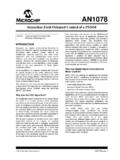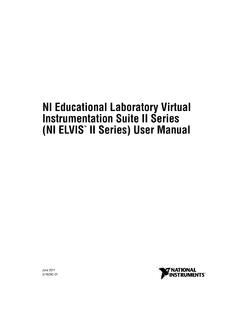Transcription of Introduction to Oscilloscope Probes: Lab Experiment
1 Introduction to Oscilloscope probes Lab Experiment A collection of lab exercises to introduce you to Oscilloscope probes , including important considerations for good signal fidelity. Revision Page 1 of 26. Introduction to Oscilloscope probes Lab Experiment Copyright Notice and Reproduction Rights 2009 Tektronix, Inc. This document may be reprinted, modified and distributed in whole or in part for the limited purpose of training users or prospective users of Tektronix oscilloscopes and instrumentation. Any reproduction must include a copy of this page containing this notice. Revision Page 2 of 26. Introduction to Oscilloscope probes Lab Experiment Table of Contents LABORATORY Experiment Introduction .
2 4. OBJECTIVES ..4. EQUIPMENT LIST ..4. OVERVIEW OF Oscilloscope probes .. 5. Introduction ..5. PERFORMANCE TERMS AND PROBE LOADING .. 10. IMPACT OF INPUT IMPACT OF INPUT CAPACITANCE ..11. IMPACT PROBE INDUCTANCE ..12. NOISE IMMUNITY ..13. DIFFERENT TYPES OF probes .. 14. PASSIVE probes ..14. ACTIVE probes ..16. DIFFERENTIAL probes ..18. CURRENT probes ..19. USING A PASSIVE 21. PROBE COMPENSATION ADJUSTMENT ..21. DIFFERENT PROBING METHODS ..23. FINAL EXERCISE .. 24. Revision Page 3 of 26. Introduction to Oscilloscope probes Lab Experiment Laboratory Experiment Introduction Objectives 1. Understand the basic characteristics of an Oscilloscope probe. 2. Describe the different types of probes and their uses.
3 3. Learn how to connect probes to various test points in a circuit. 4. Learn how probes can affect the quality of electronic measurements. Equipment List 1. One Tektronix MSO2000 or DPO2000 series digital Oscilloscope . 2. Two Tektronix P2221 1X/10X passive probes . 3. One Host/Device USB Cable. 4. One Tektronix 878-0456-xx demonstration board. Revision Page 4 of 26. Introduction to Oscilloscope probes Lab Experiment Overview of Oscilloscope probes Introduction Oscilloscope probes provide a physical and electrical connection between a signal source and an Oscilloscope . Most probes consist of a probe head, a meter or two of flexible cable, and a connector which fits on the Oscilloscope input. The probe head allows you to hold the probe while you connect the probe tip to the test point.
4 Often, this probe tip has a spring-loaded hook that allows you to attach the probe to the test point. The probe head also contains a ground connection, which provides the reference point for voltage measurements. (Remember that voltage measurements are always made relative to a reference point.). For many probes , this probe ground is a black wire with an alligator clip for easy connection to ground test points. Figure 1: Probing a circuit. Connecting a probe to a circuit can affect the operation of the circuit, and an Oscilloscope can only display and measure the signal that the probe delivers to the Oscilloscope input. The probe must have minimum impact on the probed circuit and it must maintain adequate signal fidelity for the desired measurements, or the result can be wrong or misleading.
5 Revision Page 5 of 26. Introduction to Oscilloscope probes Lab Experiment Connection Ease and Convenience The ideal probe would allow you to make the physical connection with both ease and convenience. For miniaturized circuitry, such as high-density surface mount technology (SMT), connection ease and convenience are promoted through subminiature probe heads and various probe-tip adapters. For applications such as industrial power circuitry where high voltages and larger gauge wires are common, physically larger probes with greater margins of safety are required. To make current measurements, a clamp-on current probe is required. From these few examples of physical connection, it's clear that there is no single ideal probe size or configuration for all applications.
6 Because of this, various probe sizes and configurations have been designed to meet the physical connection requirements of various applications. Figure 2: Subminiature probe head. Figure 3: Clamp-on current probe. Most probes are packaged with standard accessories. These accessories usually include a ground lead clip that you can attach to a ground signal source, a compensation adjustment tool, and one or more probe tip accessories to help connect the probe to test points. Figure 4: Typical passive probe with standard accessories. Revision Page 6 of 26. Introduction to Oscilloscope probes Lab Experiment Signal Fidelity The ideal probe would transmit any signal from probe tip to Oscilloscope input with absolute signal fidelity, meaning the signal at the Oscilloscope input would be identical to the original signal at the probe tip.
7 For absolute fidelity, the probe circuitry from tip to Oscilloscope input must have zero attenuation, infinite bandwidth, and linear phase across all frequencies. Unfortunately, the ideal probe cannot be realized. The next section will discuss key performance considerations of real probes . Key Points to Remember 1. probes provide a physical and electrical connection between the Oscilloscope and the test point. 2. Connecting a probe to a circuit affects the operation of the circuit. 3. There are different probe sizes and configurations to meet the physical connection requirements of different applications. 4. With an ideal probe, the signal at the Oscilloscope input would exactly match the signal at the test point.
8 Exercise 1. The Oscilloscope probe ground connection provides the reference point for voltage measurements. a. True b. False 2. Which of the following are desirable Oscilloscope probe attributes? (Circle all that apply.). a. Has minimum impact on the signal of interest. b. Easy to connect to the device-under-test. c. Always small and compact. d. The signal at the Oscilloscope is identical to the signal at the probe tip. Revision Page 7 of 26. Introduction to Oscilloscope probes Lab Experiment Performance Terms and Considerations Attenuation Attenuation is the ratio of the probe's input signal amplitude to the output signal amplitude, usually measured at DC. Many probes are called 10X probes , meaning that the signal applied to the Oscilloscope is 1/10th of the actual input signal amplitude.
9 It is therefore important that the Oscilloscope know the probe's attenuation and account for it in its measurements. Bandwidth Real probes have finite bandwidth. Bandwidth is the frequency at which the displayed amplitude of a sine wave is decreased by 3 dB or about 30%. Figure 5: At frequencies beyond the 3 dB point, signal amplitudes become overly attenuated and measurement results may be unpredictable. To ensure a sine wave amplitude error of not more than 3%, the bandwidth of the Oscilloscope and probe combination should be at least five times that of the circuit being tested. This is sometimes referred to as the five times rule . oscillosco pe bandwidth 5 th harmonic of signal probe bandwidth oscillosco pe bandwidth Example: If the signal of interest is 100 MHz, the Oscilloscope bandwidth and probe bandwidth should both be greater than 500 MHz.
10 Rise Time Bandwidth and rise- or fall-time have an inverse relationship. The rise time of the measurement system (probe and Oscilloscope combination) should be less than one fifth of the rise- or fall-time of the measured signal another five times rule . This should ensure an error of no more than 3% in the measured rise- or fall-time. signal rise time measuremen t system rise time . 5. measuremen t system rise time = (oscillosco pe rise time )2 + ( probe rise time )2. Example: If the signal of interest has a rise time of 50 nsec, then the measurement system rise time should be faster than 10 nsec. If the Oscilloscope has a rise time of 2 nsec, then the probe rise time should be faster than nsec.





